Westminster Business School: B2B vs. B2C Marketing Analysis Report
VerifiedAdded on 2022/08/15
|11
|2388
|13
Report
AI Summary
This report delves into the core differences between B2B and B2C marketing, highlighting the distinct approaches required for each. It examines the decision-making processes, conversion timelines, and underlying motivations of B2B and B2C customers. The report emphasizes the importance of customer journey mapping, providing a detailed analysis of the B2B customer journey, including its seven stages: problem identification, awareness generation, research, testing, pricing and negotiation, stakeholder management, and purchasing. Key ways to enhance customer experience are discussed, including a focus on customer centricity, employee satisfaction, understanding customer needs, partnership and innovation, seamless business processes, responsiveness, and proactivity. The report concludes by emphasizing the importance of these factors in improving customer satisfaction and building strong B2B relationships, supported by references to relevant literature.
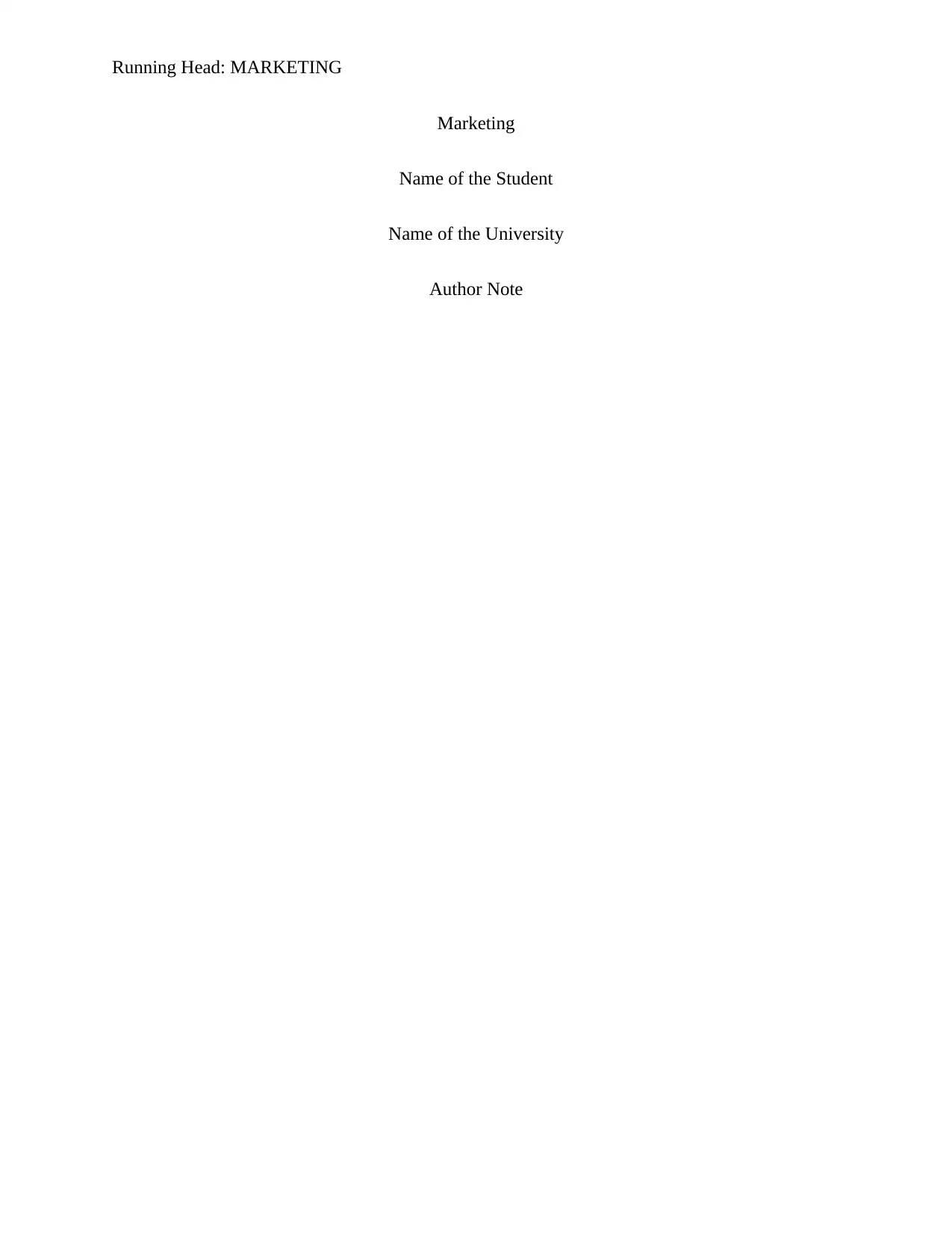
Running Head: MARKETING
Marketing
Name of the Student
Name of the University
Author Note
Marketing
Name of the Student
Name of the University
Author Note
Secure Best Marks with AI Grader
Need help grading? Try our AI Grader for instant feedback on your assignments.
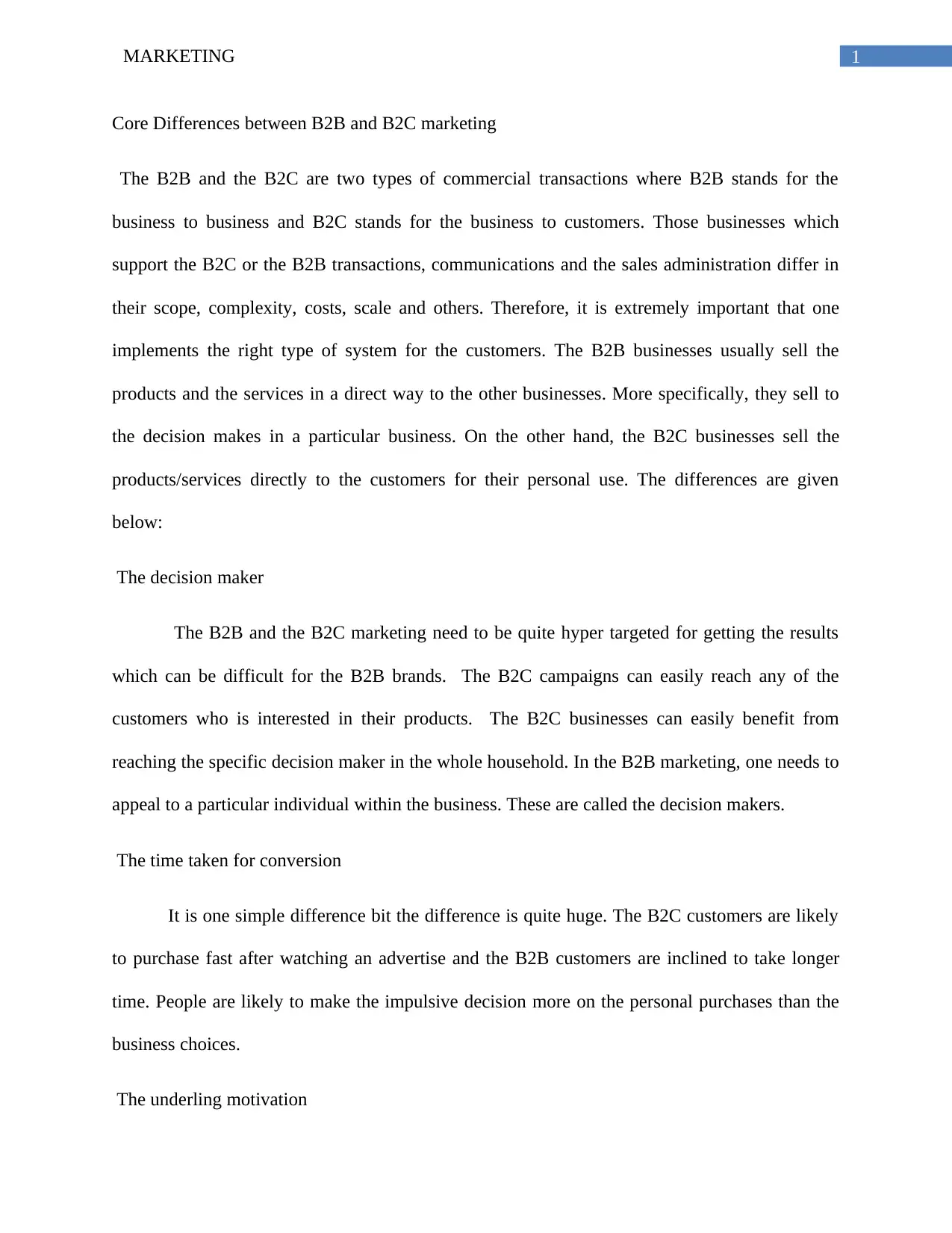
1MARKETING
Core Differences between B2B and B2C marketing
The B2B and the B2C are two types of commercial transactions where B2B stands for the
business to business and B2C stands for the business to customers. Those businesses which
support the B2C or the B2B transactions, communications and the sales administration differ in
their scope, complexity, costs, scale and others. Therefore, it is extremely important that one
implements the right type of system for the customers. The B2B businesses usually sell the
products and the services in a direct way to the other businesses. More specifically, they sell to
the decision makes in a particular business. On the other hand, the B2C businesses sell the
products/services directly to the customers for their personal use. The differences are given
below:
The decision maker
The B2B and the B2C marketing need to be quite hyper targeted for getting the results
which can be difficult for the B2B brands. The B2C campaigns can easily reach any of the
customers who is interested in their products. The B2C businesses can easily benefit from
reaching the specific decision maker in the whole household. In the B2B marketing, one needs to
appeal to a particular individual within the business. These are called the decision makers.
The time taken for conversion
It is one simple difference bit the difference is quite huge. The B2C customers are likely
to purchase fast after watching an advertise and the B2B customers are inclined to take longer
time. People are likely to make the impulsive decision more on the personal purchases than the
business choices.
The underling motivation
Core Differences between B2B and B2C marketing
The B2B and the B2C are two types of commercial transactions where B2B stands for the
business to business and B2C stands for the business to customers. Those businesses which
support the B2C or the B2B transactions, communications and the sales administration differ in
their scope, complexity, costs, scale and others. Therefore, it is extremely important that one
implements the right type of system for the customers. The B2B businesses usually sell the
products and the services in a direct way to the other businesses. More specifically, they sell to
the decision makes in a particular business. On the other hand, the B2C businesses sell the
products/services directly to the customers for their personal use. The differences are given
below:
The decision maker
The B2B and the B2C marketing need to be quite hyper targeted for getting the results
which can be difficult for the B2B brands. The B2C campaigns can easily reach any of the
customers who is interested in their products. The B2C businesses can easily benefit from
reaching the specific decision maker in the whole household. In the B2B marketing, one needs to
appeal to a particular individual within the business. These are called the decision makers.
The time taken for conversion
It is one simple difference bit the difference is quite huge. The B2C customers are likely
to purchase fast after watching an advertise and the B2B customers are inclined to take longer
time. People are likely to make the impulsive decision more on the personal purchases than the
business choices.
The underling motivation
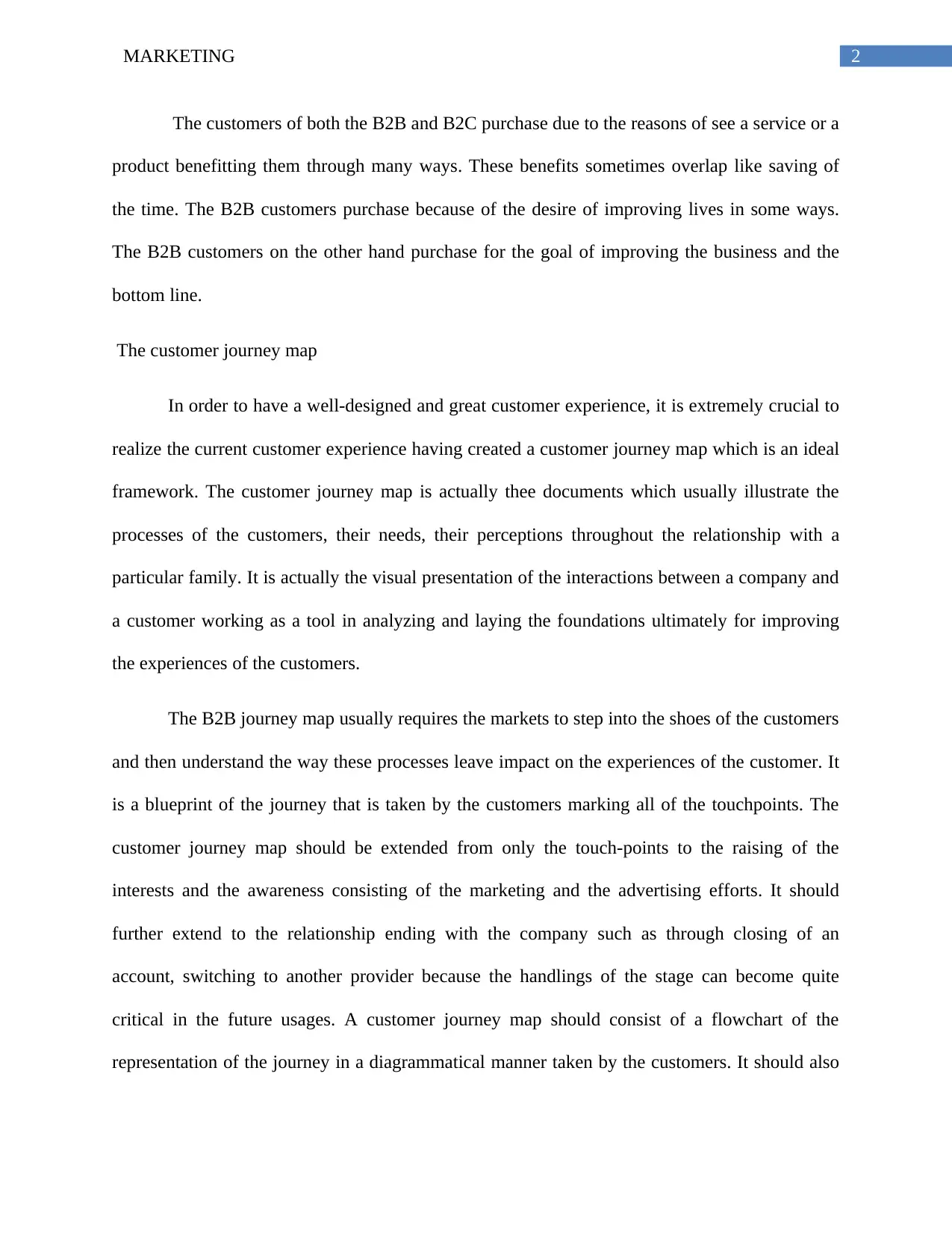
2MARKETING
The customers of both the B2B and B2C purchase due to the reasons of see a service or a
product benefitting them through many ways. These benefits sometimes overlap like saving of
the time. The B2B customers purchase because of the desire of improving lives in some ways.
The B2B customers on the other hand purchase for the goal of improving the business and the
bottom line.
The customer journey map
In order to have a well-designed and great customer experience, it is extremely crucial to
realize the current customer experience having created a customer journey map which is an ideal
framework. The customer journey map is actually thee documents which usually illustrate the
processes of the customers, their needs, their perceptions throughout the relationship with a
particular family. It is actually the visual presentation of the interactions between a company and
a customer working as a tool in analyzing and laying the foundations ultimately for improving
the experiences of the customers.
The B2B journey map usually requires the markets to step into the shoes of the customers
and then understand the way these processes leave impact on the experiences of the customer. It
is a blueprint of the journey that is taken by the customers marking all of the touchpoints. The
customer journey map should be extended from only the touch-points to the raising of the
interests and the awareness consisting of the marketing and the advertising efforts. It should
further extend to the relationship ending with the company such as through closing of an
account, switching to another provider because the handlings of the stage can become quite
critical in the future usages. A customer journey map should consist of a flowchart of the
representation of the journey in a diagrammatical manner taken by the customers. It should also
The customers of both the B2B and B2C purchase due to the reasons of see a service or a
product benefitting them through many ways. These benefits sometimes overlap like saving of
the time. The B2B customers purchase because of the desire of improving lives in some ways.
The B2B customers on the other hand purchase for the goal of improving the business and the
bottom line.
The customer journey map
In order to have a well-designed and great customer experience, it is extremely crucial to
realize the current customer experience having created a customer journey map which is an ideal
framework. The customer journey map is actually thee documents which usually illustrate the
processes of the customers, their needs, their perceptions throughout the relationship with a
particular family. It is actually the visual presentation of the interactions between a company and
a customer working as a tool in analyzing and laying the foundations ultimately for improving
the experiences of the customers.
The B2B journey map usually requires the markets to step into the shoes of the customers
and then understand the way these processes leave impact on the experiences of the customer. It
is a blueprint of the journey that is taken by the customers marking all of the touchpoints. The
customer journey map should be extended from only the touch-points to the raising of the
interests and the awareness consisting of the marketing and the advertising efforts. It should
further extend to the relationship ending with the company such as through closing of an
account, switching to another provider because the handlings of the stage can become quite
critical in the future usages. A customer journey map should consist of a flowchart of the
representation of the journey in a diagrammatical manner taken by the customers. It should also
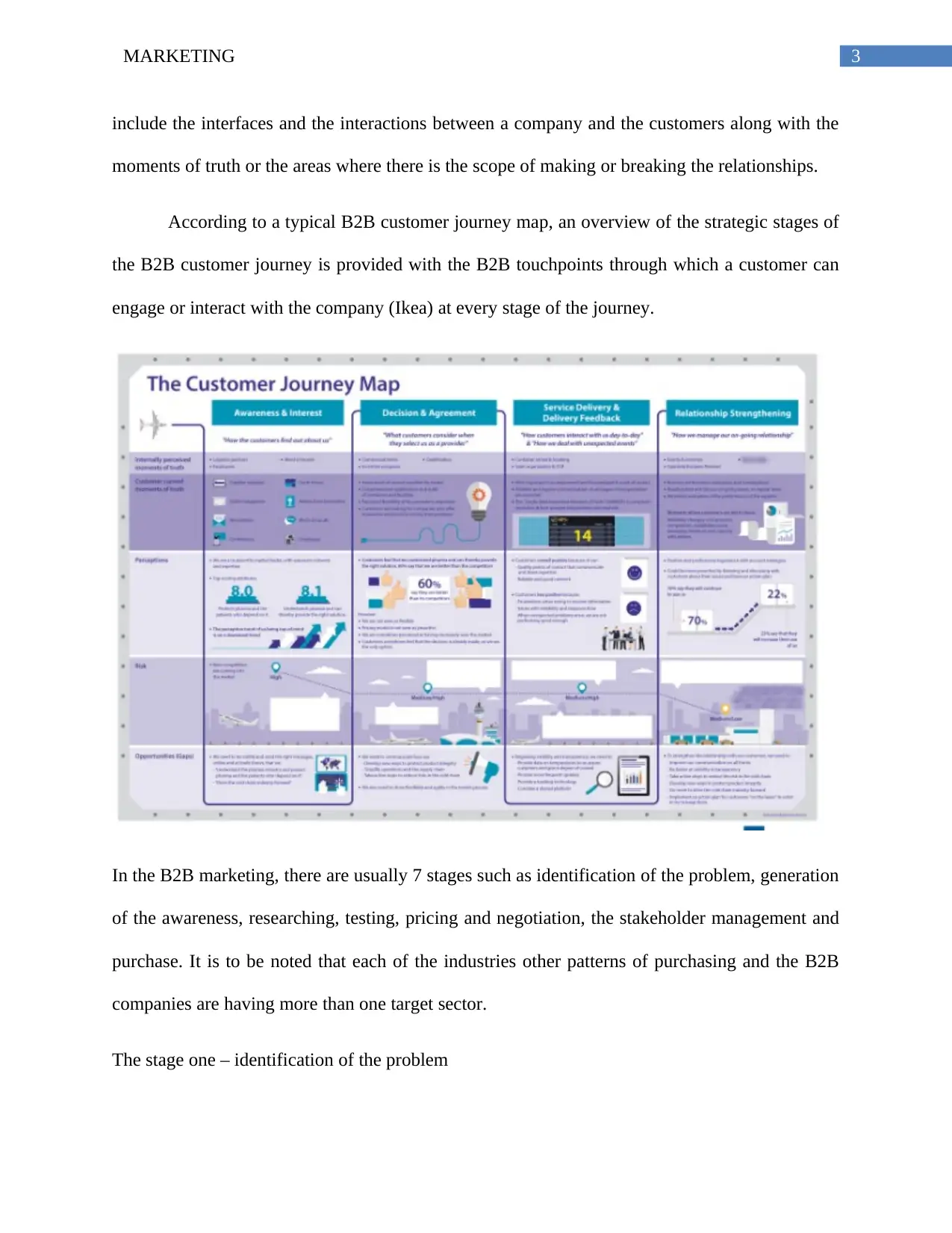
3MARKETING
include the interfaces and the interactions between a company and the customers along with the
moments of truth or the areas where there is the scope of making or breaking the relationships.
According to a typical B2B customer journey map, an overview of the strategic stages of
the B2B customer journey is provided with the B2B touchpoints through which a customer can
engage or interact with the company (Ikea) at every stage of the journey.
In the B2B marketing, there are usually 7 stages such as identification of the problem, generation
of the awareness, researching, testing, pricing and negotiation, the stakeholder management and
purchase. It is to be noted that each of the industries other patterns of purchasing and the B2B
companies are having more than one target sector.
The stage one – identification of the problem
include the interfaces and the interactions between a company and the customers along with the
moments of truth or the areas where there is the scope of making or breaking the relationships.
According to a typical B2B customer journey map, an overview of the strategic stages of
the B2B customer journey is provided with the B2B touchpoints through which a customer can
engage or interact with the company (Ikea) at every stage of the journey.
In the B2B marketing, there are usually 7 stages such as identification of the problem, generation
of the awareness, researching, testing, pricing and negotiation, the stakeholder management and
purchase. It is to be noted that each of the industries other patterns of purchasing and the B2B
companies are having more than one target sector.
The stage one – identification of the problem
Secure Best Marks with AI Grader
Need help grading? Try our AI Grader for instant feedback on your assignments.
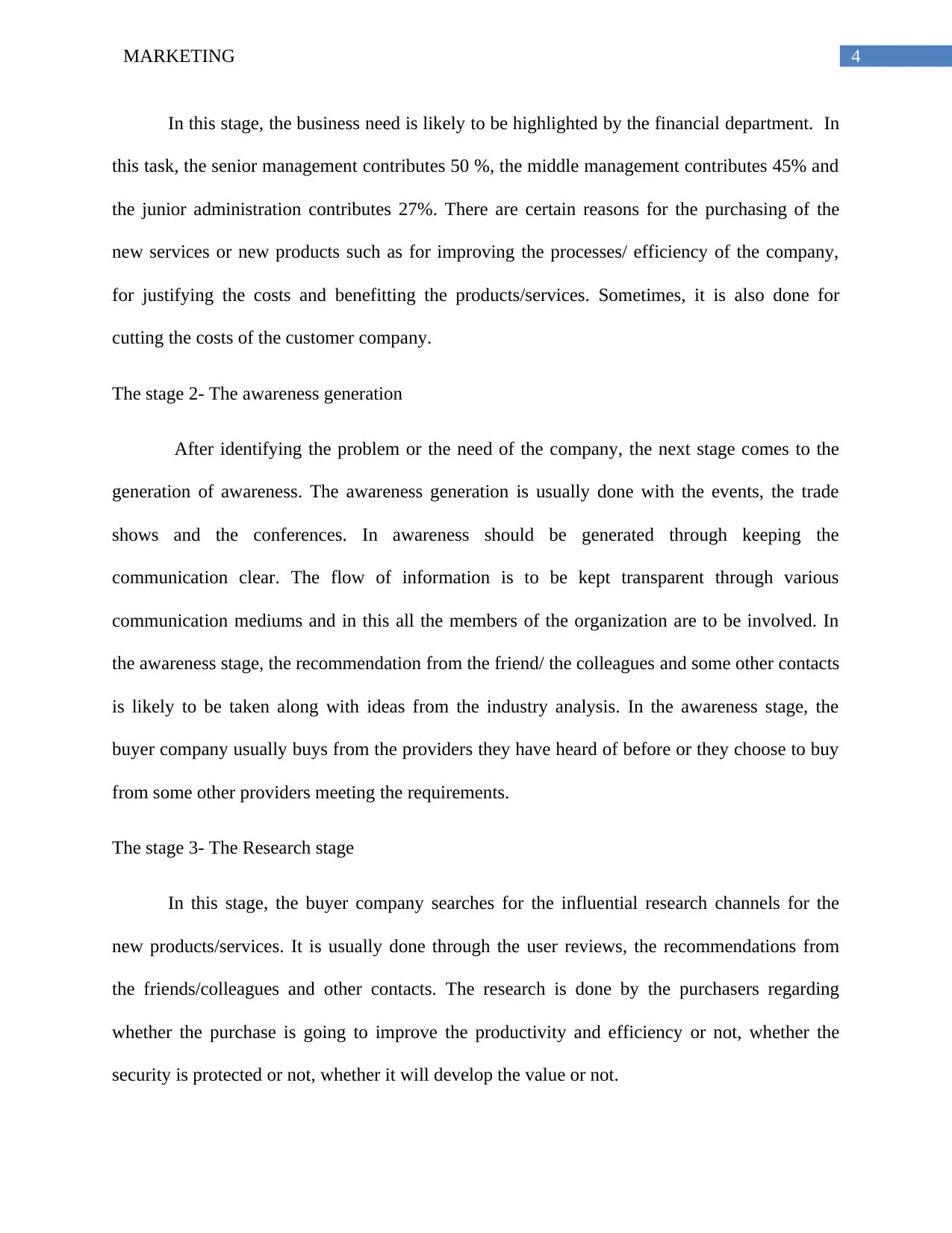
4MARKETING
In this stage, the business need is likely to be highlighted by the financial department. In
this task, the senior management contributes 50 %, the middle management contributes 45% and
the junior administration contributes 27%. There are certain reasons for the purchasing of the
new services or new products such as for improving the processes/ efficiency of the company,
for justifying the costs and benefitting the products/services. Sometimes, it is also done for
cutting the costs of the customer company.
The stage 2- The awareness generation
After identifying the problem or the need of the company, the next stage comes to the
generation of awareness. The awareness generation is usually done with the events, the trade
shows and the conferences. In awareness should be generated through keeping the
communication clear. The flow of information is to be kept transparent through various
communication mediums and in this all the members of the organization are to be involved. In
the awareness stage, the recommendation from the friend/ the colleagues and some other contacts
is likely to be taken along with ideas from the industry analysis. In the awareness stage, the
buyer company usually buys from the providers they have heard of before or they choose to buy
from some other providers meeting the requirements.
The stage 3- The Research stage
In this stage, the buyer company searches for the influential research channels for the
new products/services. It is usually done through the user reviews, the recommendations from
the friends/colleagues and other contacts. The research is done by the purchasers regarding
whether the purchase is going to improve the productivity and efficiency or not, whether the
security is protected or not, whether it will develop the value or not.
In this stage, the business need is likely to be highlighted by the financial department. In
this task, the senior management contributes 50 %, the middle management contributes 45% and
the junior administration contributes 27%. There are certain reasons for the purchasing of the
new services or new products such as for improving the processes/ efficiency of the company,
for justifying the costs and benefitting the products/services. Sometimes, it is also done for
cutting the costs of the customer company.
The stage 2- The awareness generation
After identifying the problem or the need of the company, the next stage comes to the
generation of awareness. The awareness generation is usually done with the events, the trade
shows and the conferences. In awareness should be generated through keeping the
communication clear. The flow of information is to be kept transparent through various
communication mediums and in this all the members of the organization are to be involved. In
the awareness stage, the recommendation from the friend/ the colleagues and some other contacts
is likely to be taken along with ideas from the industry analysis. In the awareness stage, the
buyer company usually buys from the providers they have heard of before or they choose to buy
from some other providers meeting the requirements.
The stage 3- The Research stage
In this stage, the buyer company searches for the influential research channels for the
new products/services. It is usually done through the user reviews, the recommendations from
the friends/colleagues and other contacts. The research is done by the purchasers regarding
whether the purchase is going to improve the productivity and efficiency or not, whether the
security is protected or not, whether it will develop the value or not.
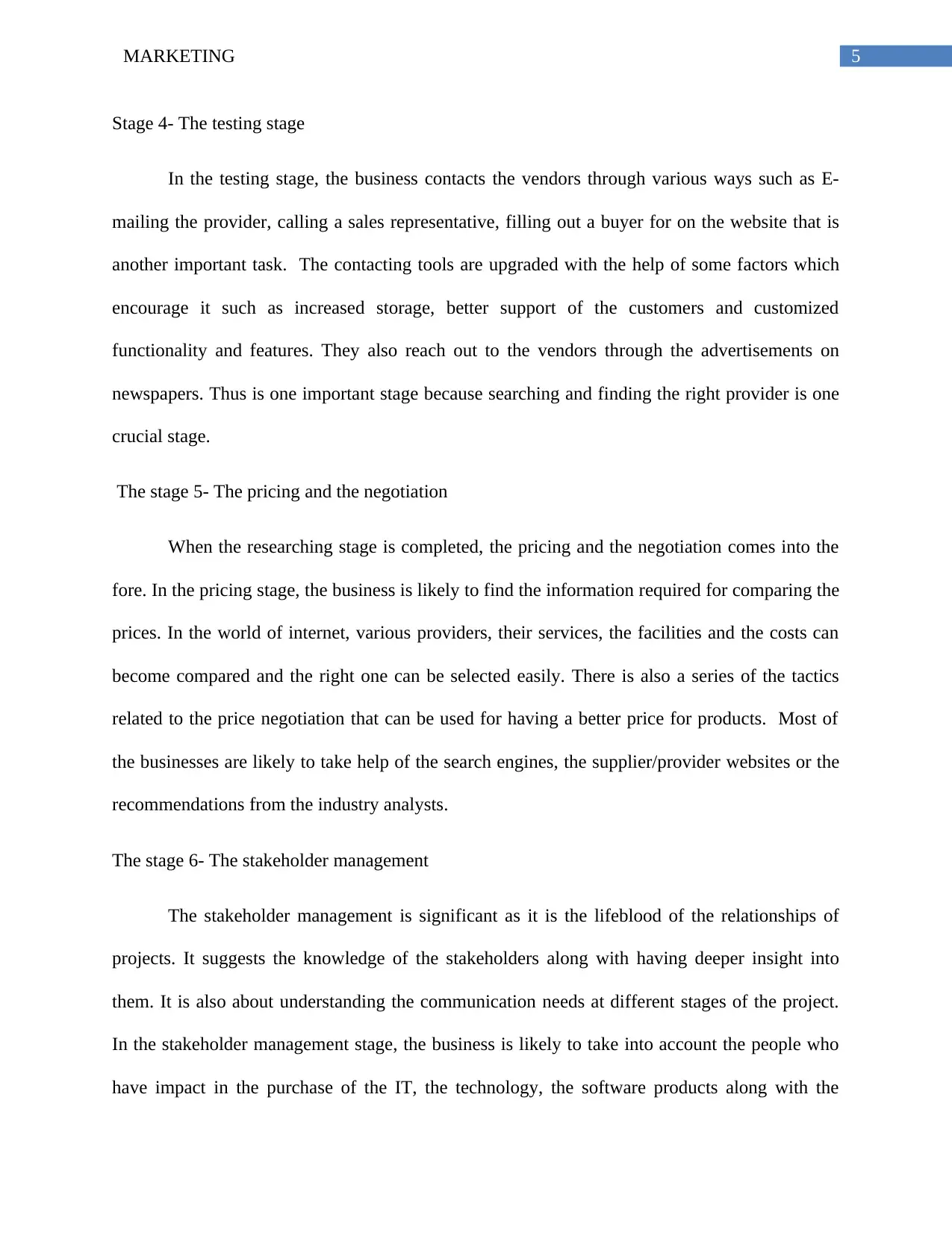
5MARKETING
Stage 4- The testing stage
In the testing stage, the business contacts the vendors through various ways such as E-
mailing the provider, calling a sales representative, filling out a buyer for on the website that is
another important task. The contacting tools are upgraded with the help of some factors which
encourage it such as increased storage, better support of the customers and customized
functionality and features. They also reach out to the vendors through the advertisements on
newspapers. Thus is one important stage because searching and finding the right provider is one
crucial stage.
The stage 5- The pricing and the negotiation
When the researching stage is completed, the pricing and the negotiation comes into the
fore. In the pricing stage, the business is likely to find the information required for comparing the
prices. In the world of internet, various providers, their services, the facilities and the costs can
become compared and the right one can be selected easily. There is also a series of the tactics
related to the price negotiation that can be used for having a better price for products. Most of
the businesses are likely to take help of the search engines, the supplier/provider websites or the
recommendations from the industry analysts.
The stage 6- The stakeholder management
The stakeholder management is significant as it is the lifeblood of the relationships of
projects. It suggests the knowledge of the stakeholders along with having deeper insight into
them. It is also about understanding the communication needs at different stages of the project.
In the stakeholder management stage, the business is likely to take into account the people who
have impact in the purchase of the IT, the technology, the software products along with the
Stage 4- The testing stage
In the testing stage, the business contacts the vendors through various ways such as E-
mailing the provider, calling a sales representative, filling out a buyer for on the website that is
another important task. The contacting tools are upgraded with the help of some factors which
encourage it such as increased storage, better support of the customers and customized
functionality and features. They also reach out to the vendors through the advertisements on
newspapers. Thus is one important stage because searching and finding the right provider is one
crucial stage.
The stage 5- The pricing and the negotiation
When the researching stage is completed, the pricing and the negotiation comes into the
fore. In the pricing stage, the business is likely to find the information required for comparing the
prices. In the world of internet, various providers, their services, the facilities and the costs can
become compared and the right one can be selected easily. There is also a series of the tactics
related to the price negotiation that can be used for having a better price for products. Most of
the businesses are likely to take help of the search engines, the supplier/provider websites or the
recommendations from the industry analysts.
The stage 6- The stakeholder management
The stakeholder management is significant as it is the lifeblood of the relationships of
projects. It suggests the knowledge of the stakeholders along with having deeper insight into
them. It is also about understanding the communication needs at different stages of the project.
In the stakeholder management stage, the business is likely to take into account the people who
have impact in the purchase of the IT, the technology, the software products along with the
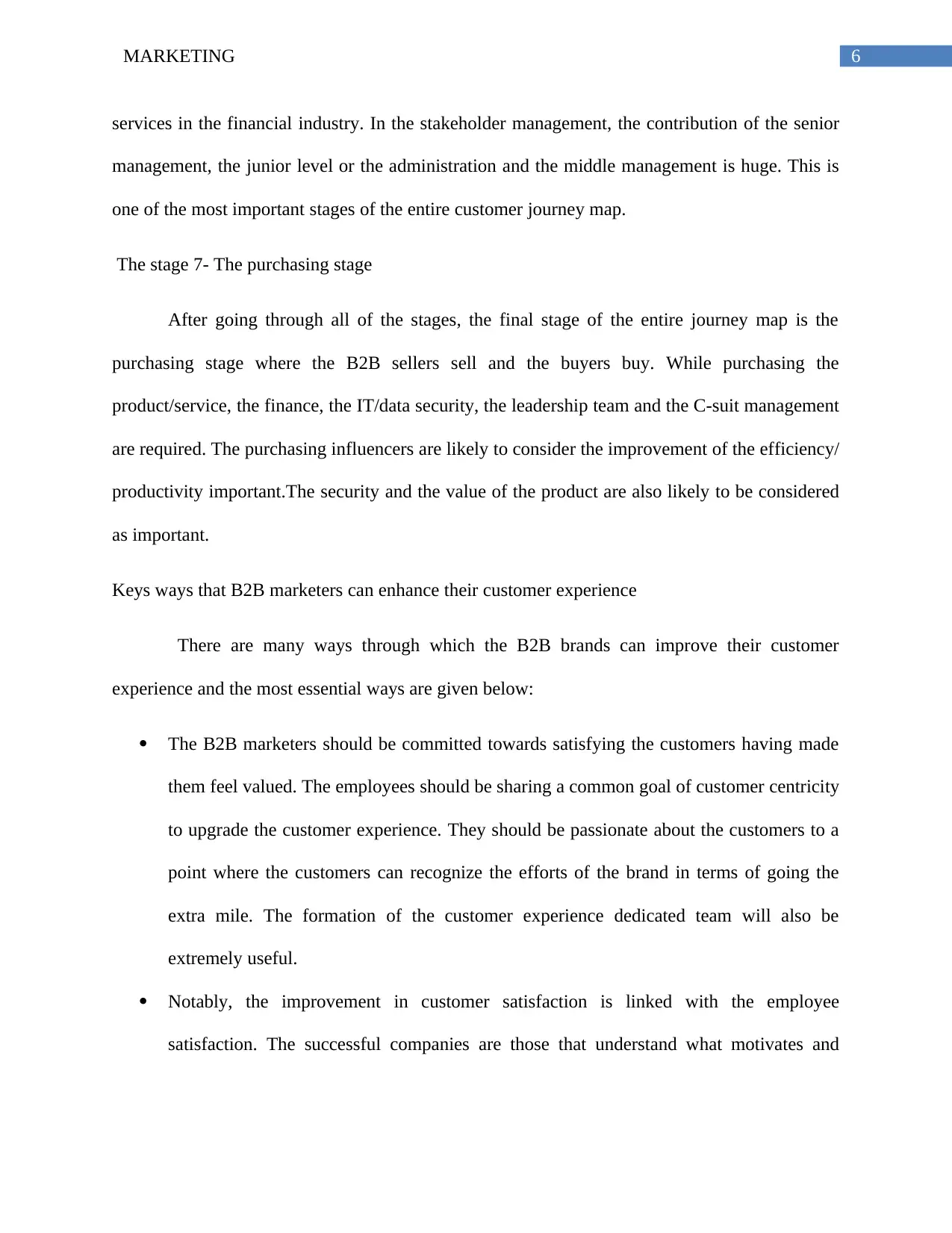
6MARKETING
services in the financial industry. In the stakeholder management, the contribution of the senior
management, the junior level or the administration and the middle management is huge. This is
one of the most important stages of the entire customer journey map.
The stage 7- The purchasing stage
After going through all of the stages, the final stage of the entire journey map is the
purchasing stage where the B2B sellers sell and the buyers buy. While purchasing the
product/service, the finance, the IT/data security, the leadership team and the C-suit management
are required. The purchasing influencers are likely to consider the improvement of the efficiency/
productivity important.The security and the value of the product are also likely to be considered
as important.
Keys ways that B2B marketers can enhance their customer experience
There are many ways through which the B2B brands can improve their customer
experience and the most essential ways are given below:
The B2B marketers should be committed towards satisfying the customers having made
them feel valued. The employees should be sharing a common goal of customer centricity
to upgrade the customer experience. They should be passionate about the customers to a
point where the customers can recognize the efforts of the brand in terms of going the
extra mile. The formation of the customer experience dedicated team will also be
extremely useful.
Notably, the improvement in customer satisfaction is linked with the employee
satisfaction. The successful companies are those that understand what motivates and
services in the financial industry. In the stakeholder management, the contribution of the senior
management, the junior level or the administration and the middle management is huge. This is
one of the most important stages of the entire customer journey map.
The stage 7- The purchasing stage
After going through all of the stages, the final stage of the entire journey map is the
purchasing stage where the B2B sellers sell and the buyers buy. While purchasing the
product/service, the finance, the IT/data security, the leadership team and the C-suit management
are required. The purchasing influencers are likely to consider the improvement of the efficiency/
productivity important.The security and the value of the product are also likely to be considered
as important.
Keys ways that B2B marketers can enhance their customer experience
There are many ways through which the B2B brands can improve their customer
experience and the most essential ways are given below:
The B2B marketers should be committed towards satisfying the customers having made
them feel valued. The employees should be sharing a common goal of customer centricity
to upgrade the customer experience. They should be passionate about the customers to a
point where the customers can recognize the efforts of the brand in terms of going the
extra mile. The formation of the customer experience dedicated team will also be
extremely useful.
Notably, the improvement in customer satisfaction is linked with the employee
satisfaction. The successful companies are those that understand what motivates and
Paraphrase This Document
Need a fresh take? Get an instant paraphrase of this document with our AI Paraphraser
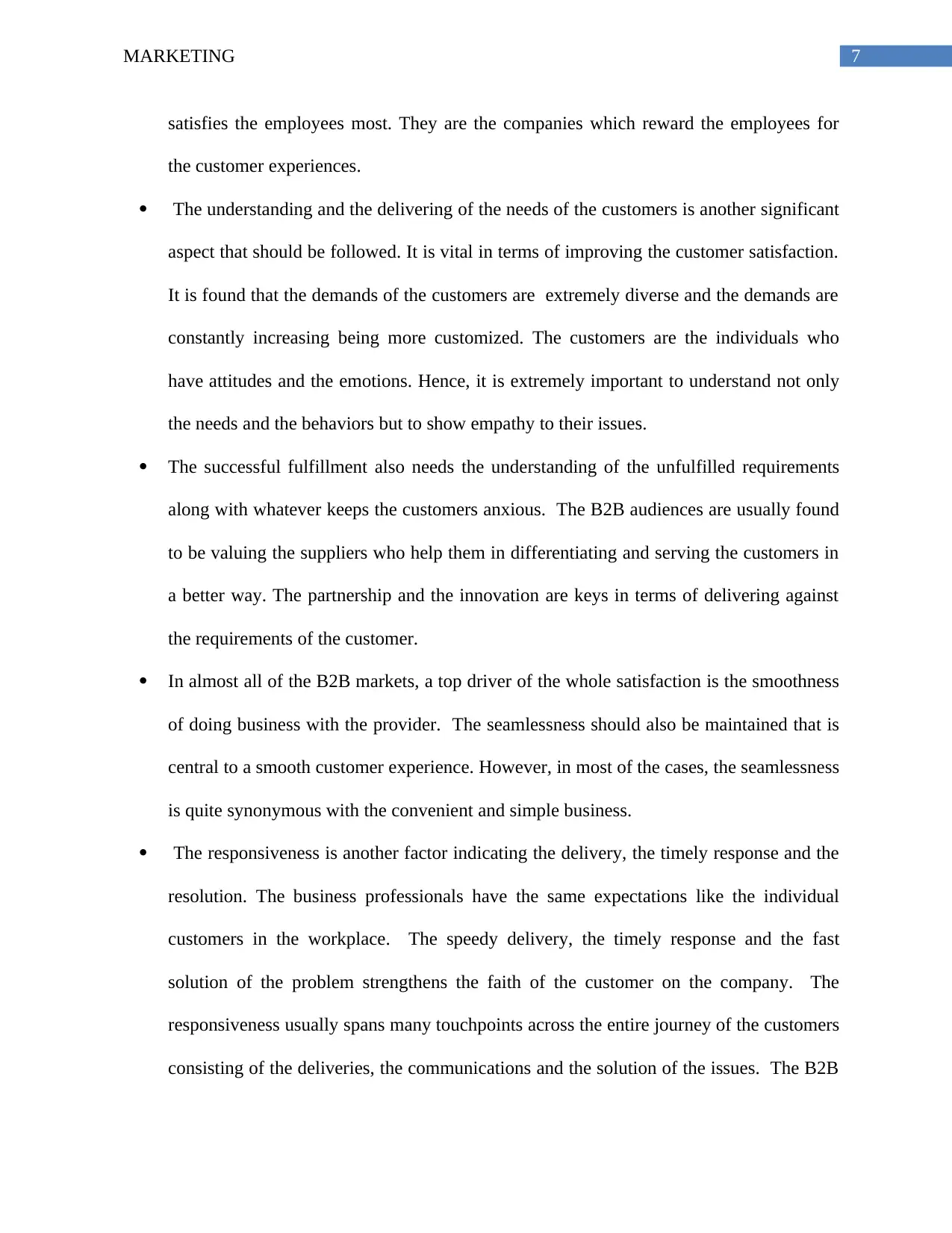
7MARKETING
satisfies the employees most. They are the companies which reward the employees for
the customer experiences.
The understanding and the delivering of the needs of the customers is another significant
aspect that should be followed. It is vital in terms of improving the customer satisfaction.
It is found that the demands of the customers are extremely diverse and the demands are
constantly increasing being more customized. The customers are the individuals who
have attitudes and the emotions. Hence, it is extremely important to understand not only
the needs and the behaviors but to show empathy to their issues.
The successful fulfillment also needs the understanding of the unfulfilled requirements
along with whatever keeps the customers anxious. The B2B audiences are usually found
to be valuing the suppliers who help them in differentiating and serving the customers in
a better way. The partnership and the innovation are keys in terms of delivering against
the requirements of the customer.
In almost all of the B2B markets, a top driver of the whole satisfaction is the smoothness
of doing business with the provider. The seamlessness should also be maintained that is
central to a smooth customer experience. However, in most of the cases, the seamlessness
is quite synonymous with the convenient and simple business.
The responsiveness is another factor indicating the delivery, the timely response and the
resolution. The business professionals have the same expectations like the individual
customers in the workplace. The speedy delivery, the timely response and the fast
solution of the problem strengthens the faith of the customer on the company. The
responsiveness usually spans many touchpoints across the entire journey of the customers
consisting of the deliveries, the communications and the solution of the issues. The B2B
satisfies the employees most. They are the companies which reward the employees for
the customer experiences.
The understanding and the delivering of the needs of the customers is another significant
aspect that should be followed. It is vital in terms of improving the customer satisfaction.
It is found that the demands of the customers are extremely diverse and the demands are
constantly increasing being more customized. The customers are the individuals who
have attitudes and the emotions. Hence, it is extremely important to understand not only
the needs and the behaviors but to show empathy to their issues.
The successful fulfillment also needs the understanding of the unfulfilled requirements
along with whatever keeps the customers anxious. The B2B audiences are usually found
to be valuing the suppliers who help them in differentiating and serving the customers in
a better way. The partnership and the innovation are keys in terms of delivering against
the requirements of the customer.
In almost all of the B2B markets, a top driver of the whole satisfaction is the smoothness
of doing business with the provider. The seamlessness should also be maintained that is
central to a smooth customer experience. However, in most of the cases, the seamlessness
is quite synonymous with the convenient and simple business.
The responsiveness is another factor indicating the delivery, the timely response and the
resolution. The business professionals have the same expectations like the individual
customers in the workplace. The speedy delivery, the timely response and the fast
solution of the problem strengthens the faith of the customer on the company. The
responsiveness usually spans many touchpoints across the entire journey of the customers
consisting of the deliveries, the communications and the solution of the issues. The B2B
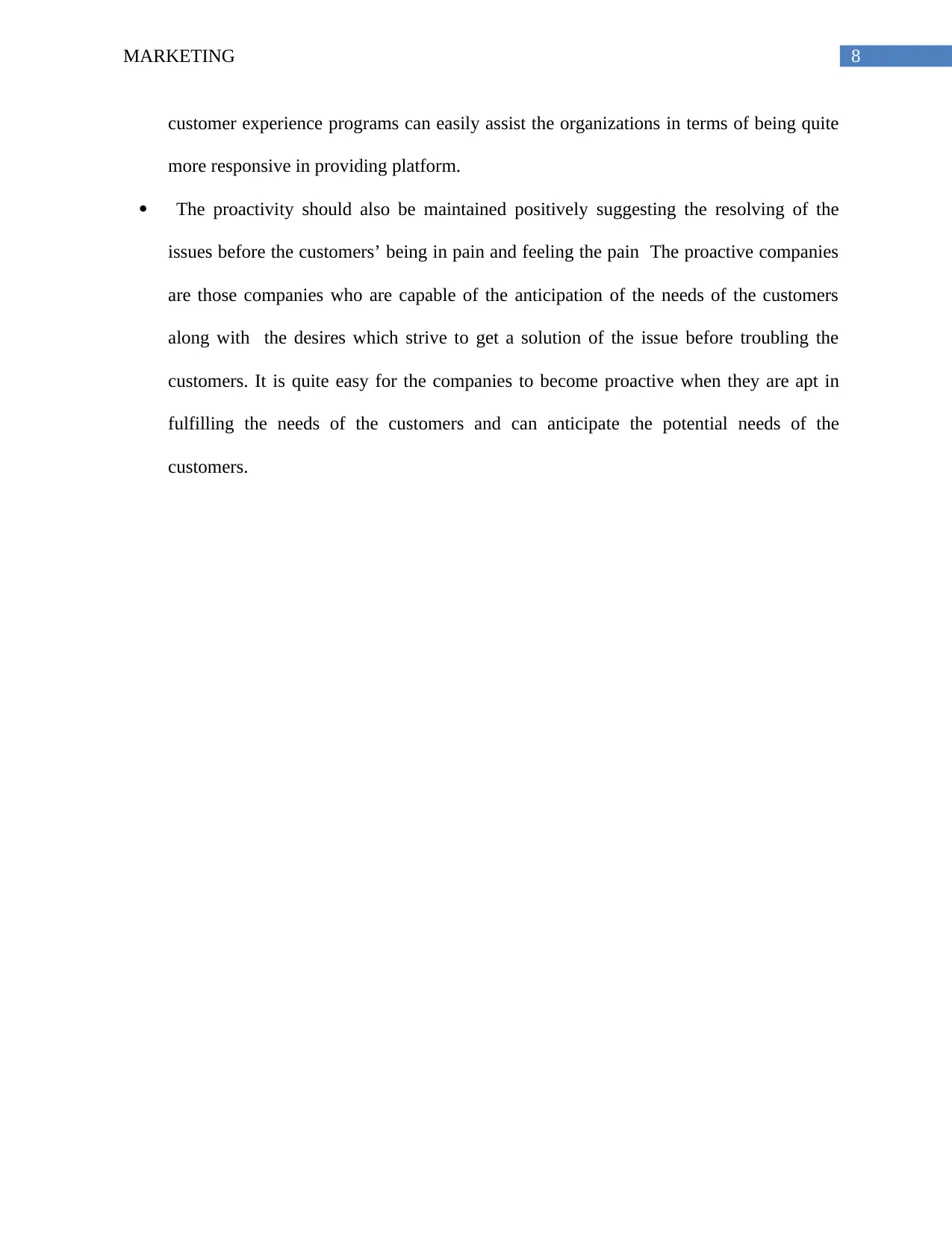
8MARKETING
customer experience programs can easily assist the organizations in terms of being quite
more responsive in providing platform.
The proactivity should also be maintained positively suggesting the resolving of the
issues before the customers’ being in pain and feeling the pain The proactive companies
are those companies who are capable of the anticipation of the needs of the customers
along with the desires which strive to get a solution of the issue before troubling the
customers. It is quite easy for the companies to become proactive when they are apt in
fulfilling the needs of the customers and can anticipate the potential needs of the
customers.
customer experience programs can easily assist the organizations in terms of being quite
more responsive in providing platform.
The proactivity should also be maintained positively suggesting the resolving of the
issues before the customers’ being in pain and feeling the pain The proactive companies
are those companies who are capable of the anticipation of the needs of the customers
along with the desires which strive to get a solution of the issue before troubling the
customers. It is quite easy for the companies to become proactive when they are apt in
fulfilling the needs of the customers and can anticipate the potential needs of the
customers.
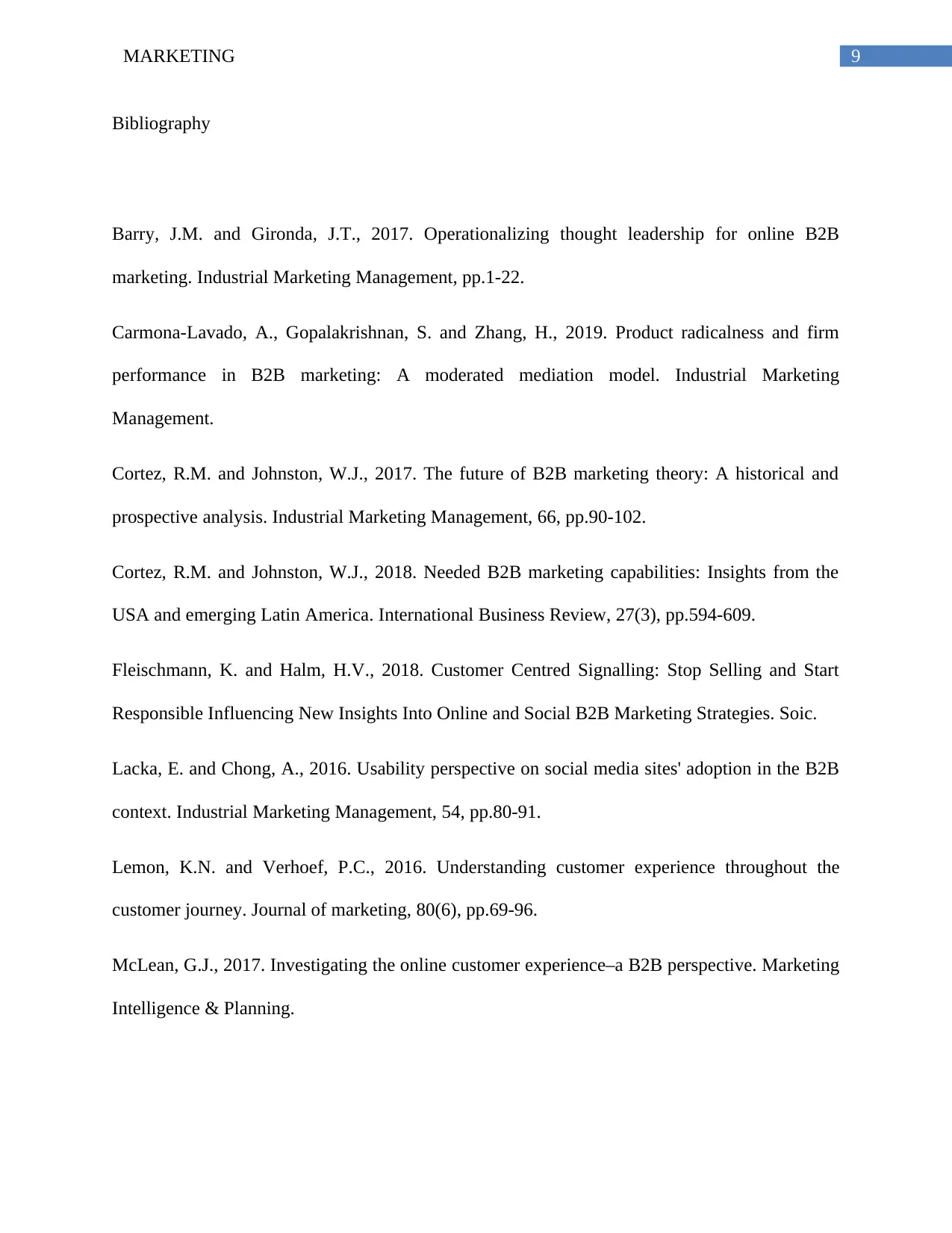
9MARKETING
Bibliography
Barry, J.M. and Gironda, J.T., 2017. Operationalizing thought leadership for online B2B
marketing. Industrial Marketing Management, pp.1-22.
Carmona-Lavado, A., Gopalakrishnan, S. and Zhang, H., 2019. Product radicalness and firm
performance in B2B marketing: A moderated mediation model. Industrial Marketing
Management.
Cortez, R.M. and Johnston, W.J., 2017. The future of B2B marketing theory: A historical and
prospective analysis. Industrial Marketing Management, 66, pp.90-102.
Cortez, R.M. and Johnston, W.J., 2018. Needed B2B marketing capabilities: Insights from the
USA and emerging Latin America. International Business Review, 27(3), pp.594-609.
Fleischmann, K. and Halm, H.V., 2018. Customer Centred Signalling: Stop Selling and Start
Responsible Influencing New Insights Into Online and Social B2B Marketing Strategies. Soic.
Lacka, E. and Chong, A., 2016. Usability perspective on social media sites' adoption in the B2B
context. Industrial Marketing Management, 54, pp.80-91.
Lemon, K.N. and Verhoef, P.C., 2016. Understanding customer experience throughout the
customer journey. Journal of marketing, 80(6), pp.69-96.
McLean, G.J., 2017. Investigating the online customer experience–a B2B perspective. Marketing
Intelligence & Planning.
Bibliography
Barry, J.M. and Gironda, J.T., 2017. Operationalizing thought leadership for online B2B
marketing. Industrial Marketing Management, pp.1-22.
Carmona-Lavado, A., Gopalakrishnan, S. and Zhang, H., 2019. Product radicalness and firm
performance in B2B marketing: A moderated mediation model. Industrial Marketing
Management.
Cortez, R.M. and Johnston, W.J., 2017. The future of B2B marketing theory: A historical and
prospective analysis. Industrial Marketing Management, 66, pp.90-102.
Cortez, R.M. and Johnston, W.J., 2018. Needed B2B marketing capabilities: Insights from the
USA and emerging Latin America. International Business Review, 27(3), pp.594-609.
Fleischmann, K. and Halm, H.V., 2018. Customer Centred Signalling: Stop Selling and Start
Responsible Influencing New Insights Into Online and Social B2B Marketing Strategies. Soic.
Lacka, E. and Chong, A., 2016. Usability perspective on social media sites' adoption in the B2B
context. Industrial Marketing Management, 54, pp.80-91.
Lemon, K.N. and Verhoef, P.C., 2016. Understanding customer experience throughout the
customer journey. Journal of marketing, 80(6), pp.69-96.
McLean, G.J., 2017. Investigating the online customer experience–a B2B perspective. Marketing
Intelligence & Planning.
Secure Best Marks with AI Grader
Need help grading? Try our AI Grader for instant feedback on your assignments.
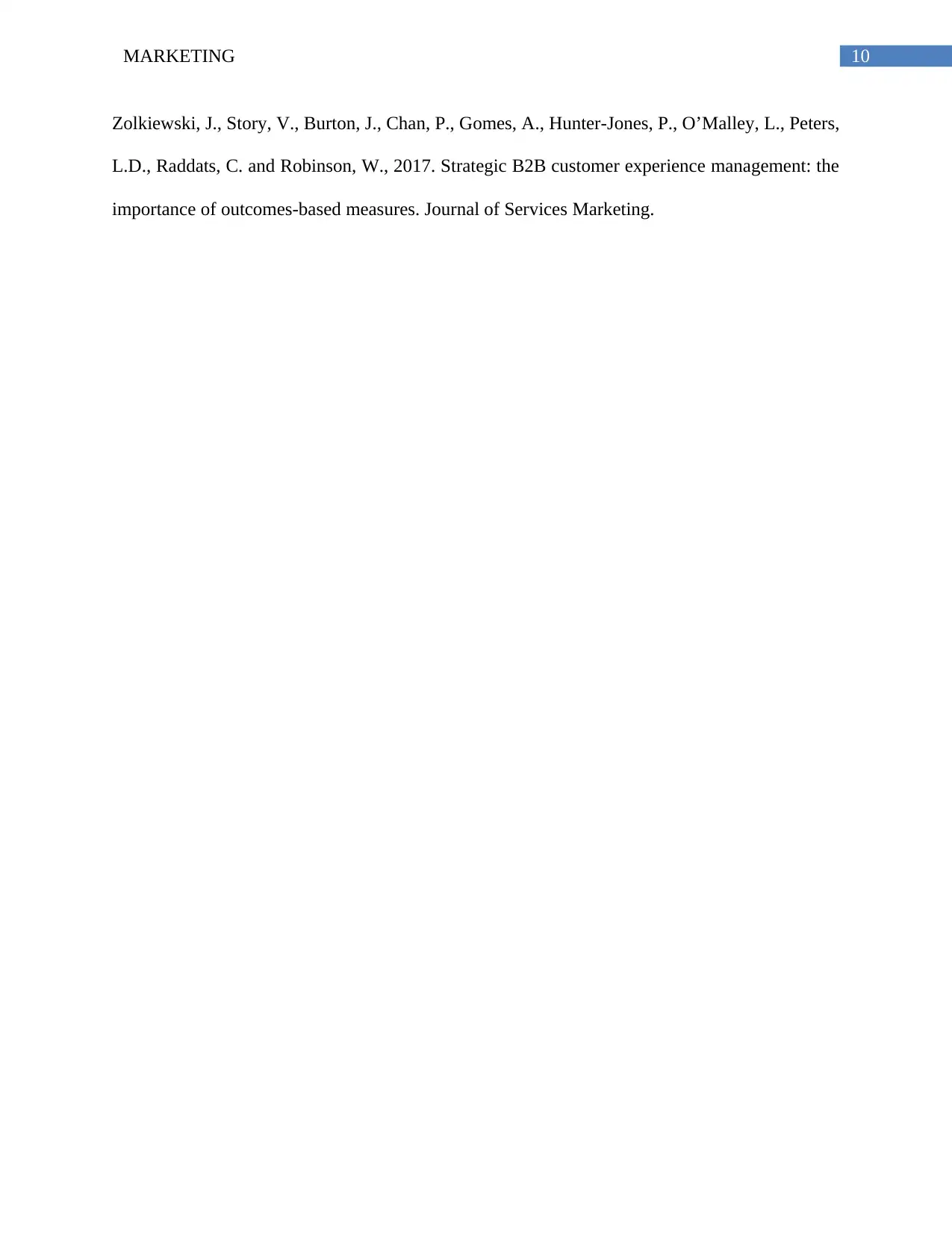
10MARKETING
Zolkiewski, J., Story, V., Burton, J., Chan, P., Gomes, A., Hunter-Jones, P., O’Malley, L., Peters,
L.D., Raddats, C. and Robinson, W., 2017. Strategic B2B customer experience management: the
importance of outcomes-based measures. Journal of Services Marketing.
Zolkiewski, J., Story, V., Burton, J., Chan, P., Gomes, A., Hunter-Jones, P., O’Malley, L., Peters,
L.D., Raddats, C. and Robinson, W., 2017. Strategic B2B customer experience management: the
importance of outcomes-based measures. Journal of Services Marketing.
1 out of 11
Related Documents
Your All-in-One AI-Powered Toolkit for Academic Success.
+13062052269
info@desklib.com
Available 24*7 on WhatsApp / Email
![[object Object]](/_next/static/media/star-bottom.7253800d.svg)
Unlock your academic potential
© 2024 | Zucol Services PVT LTD | All rights reserved.




